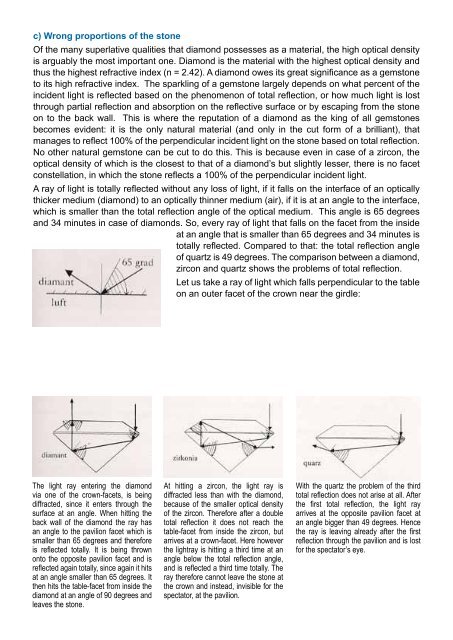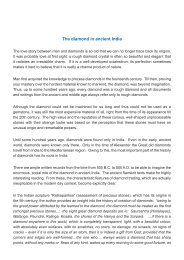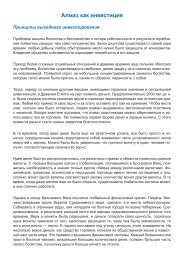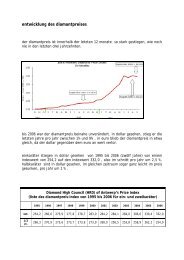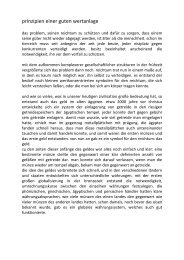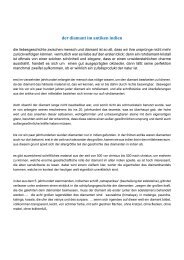A diamond is born - Diamantschleiferei Michael Bonke
A diamond is born - Diamantschleiferei Michael Bonke
A diamond is born - Diamantschleiferei Michael Bonke
- No tags were found...
You also want an ePaper? Increase the reach of your titles
YUMPU automatically turns print PDFs into web optimized ePapers that Google loves.
c) Wrong proportions of the stoneOf the many superlative qualities that <strong>diamond</strong> possesses as a material, the high optical density<strong>is</strong> arguably the most important one. Diamond <strong>is</strong> the material with the highest optical density andthus the highest refractive index (n = 2.42). A <strong>diamond</strong> owes its great significance as a gemstoneto its high refractive index. The sparkling of a gemstone largely depends on what percent of theincident light <strong>is</strong> reflected based on the phenomenon of total reflection, or how much light <strong>is</strong> lostthrough partial reflection and absorption on the reflective surface or by escaping from the stoneon to the back wall. Th<strong>is</strong> <strong>is</strong> where the reputation of a <strong>diamond</strong> as the king of all gemstonesbecomes evident: it <strong>is</strong> the only natural material (and only in the cut form of a brilliant), thatmanages to reflect 100% of the perpendicular incident light on the stone based on total reflection.No other natural gemstone can be cut to do th<strong>is</strong>. Th<strong>is</strong> <strong>is</strong> because even in case of a zircon, theoptical density of which <strong>is</strong> the closest to that of a <strong>diamond</strong>’s but slightly lesser, there <strong>is</strong> no facetconstellation, in which the stone reflects a 100% of the perpendicular incident light.A ray of light <strong>is</strong> totally reflected without any loss of light, if it falls on the interface of an opticallythicker medium (<strong>diamond</strong>) to an optically thinner medium (air), if it <strong>is</strong> at an angle to the interface,which <strong>is</strong> smaller than the total reflection angle of the optical medium. Th<strong>is</strong> angle <strong>is</strong> 65 degreesand 34 minutes in case of <strong>diamond</strong>s. So, every ray of light that falls on the facet from the insideat an angle that <strong>is</strong> smaller than 65 degrees and 34 minutes <strong>is</strong>totally reflected. Compared to that: the total reflection angleof quartz <strong>is</strong> 49 degrees. The compar<strong>is</strong>on between a <strong>diamond</strong>,zircon and quartz shows the problems of total reflection.Let us take a ray of light which falls perpendicular to the tableon an outer facet of the crown near the girdle:The light ray entering the <strong>diamond</strong>via one of the crown-facets, <strong>is</strong> beingdiffracted, since it enters through thesurface at an angle. When hitting theback wall of the <strong>diamond</strong> the ray hasan angle to the pavilion facet which <strong>is</strong>smaller than 65 degrees and therefore<strong>is</strong> reflected totally. It <strong>is</strong> being thrownonto the opposite pavilion facet and <strong>is</strong>reflected again totally, since again it hitsat an angle smaller than 65 degrees. Itthen hits the table-facet from inside the<strong>diamond</strong> at an angle of 90 degrees andleaves the stone.At hitting a zircon, the light ray <strong>is</strong>diffracted less than with the <strong>diamond</strong>,because of the smaller optical densityof the zircon. Therefore after a doubletotal reflection it does not reach thetable-facet from inside the zircon, butarrives at a crown-facet. Here howeverthe lightray <strong>is</strong> hitting a third time at anangle below the total reflection angle,and <strong>is</strong> reflected a third time totally. Theray therefore cannot leave the stone atthe crown and instead, inv<strong>is</strong>ible for thespectator, at the pavilion.With the quartz the problem of the thirdtotal reflection does not ar<strong>is</strong>e at all. Afterthe first total reflection, the light rayarrives at the opposite pavilion facet atan angle bigger than 49 degrees. Hencethe ray <strong>is</strong> leaving already after the firstreflection through the pavilion and <strong>is</strong> lostfor the spectator’s eye.


